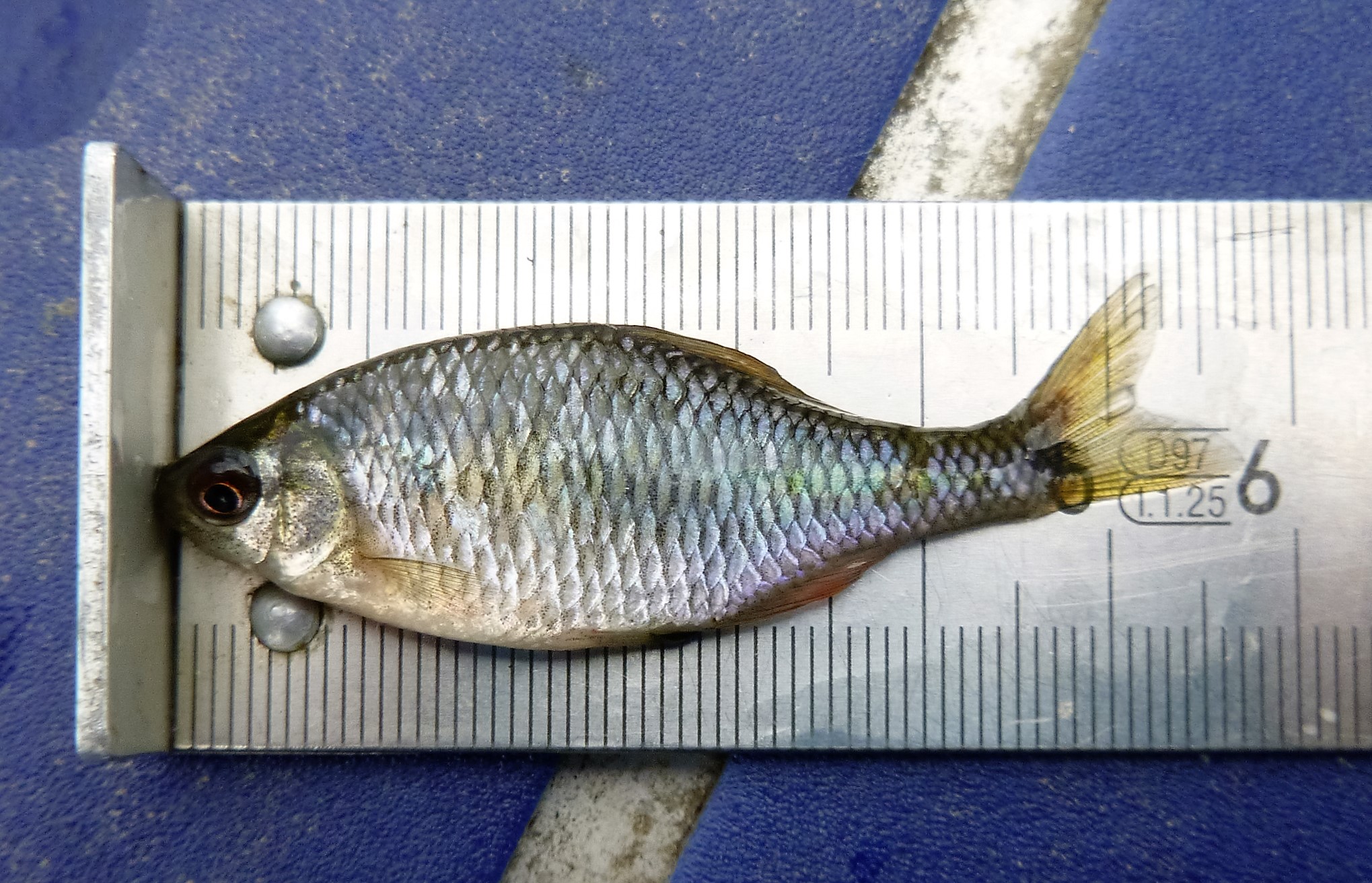Bitterling
- Category: Fish fauna - species
- Published: Wednesday, 26 October 2016 12:10
- Written by Super User
Bitterling,
Rhodeus amarus (Bloch, 1782)
Species description
Bitterling is a small fish belonging to the carp family, reaching up to 9 cm of total length. Its body is flattened laterally and covered with cycloid scales (Photo. 1). Along the axis of the body, there are up to 40 scales. The lateral line passes through only 5-6 scales. During breeding season, bitterlings exhibit sexual dimorphism – male’s dorsal and anal fins turn red and gets black colour at the edges.

Bitterling is on the list of animals being under partial protection in Poland (Regulation of the Minister of the Environment of 6 October 2014 on the protection of animals species, Journal of Laws 2014, item 1348). It is also a species of the European Community interest and therefore it is listed in the Annex II of the Habitat Directive (Council Directive 92/43/EEC of 21 May 1992 on the conservation of natural habitats and of wild fauna and flora).
Biology
Bitterlings belong to short-lived species, the oldest specimen found in Polish population lived up to 6 years (Przybylski and Garcia-Berthou 2004). In the second year of life, bitterlings are ready to reproduce (Smith et al. 2004). During their breeding season, which lasts from the end of April to the beginning of July, males establish their territories. Bitterlings belong to ostracophillic animals (Krizanowski 1949, Balon 1975) so in order to reproduce, they require the presence of bivalves from the family Unionidae. Females, in the territory of chosen males, lay eggs inside the mantle of the unio using the ovipositor. At the same time, males deposit sperm cells in the vicinity of the gills of the unio. Fertilization takes place in the gill demibranch. Young bitterlings leave bivalves after 20-40 days of incubation (Aldige 1999), when their total body length is 7-8 mm (Balon 1959).
Bitterlings have a highly selective diet. They feed mostly on detritus, debris of vascular plants and algae. The species feeds mainly during the day and its activity significantly declines at night (Przybylski 1996).
Habitat
Generally, bitterlings exhibit low tolerance to changes in ecological conditions (Grandmottet 1983), however, they can survive during oxygen deficiencies (Wissing i Zobe 1988) and variable water temperature (Zahn 1964). The species prefers stagnant or slow-flowing waters including oxbows densely overgrown with water plants. Due to specific reproduction requirements, the occurrence of bitterlings dependents on the presence of bivalves from the Unionidae family.
Distribution
Bitterling is a common species in Poland, found all over the country except for southern mountainous streams (Przybylski 2012) The presence of this species was confirmed in the Polish coastal lagoons during studies aiming at elaboration of conservations plans for Nature 2000 areas: in Mewia Łacha Reserve – Ostoja w Ujściu Wisły (PLH 220044) and in the Elbląg Bay – Vistula Lagoon and Vistula Spit (PLH 280007, (Michałek et al. 2015).
Bitterling is monitored at four sites, within the framework of the project ”Pilot monitoring studies of marine habitats and protected species in 2015-2018":
- Ujście Wisły (Mewia Łacha Reserve),
- Jezioro Bukowo,
- Jezioro Łebsko,
- Zalew Wiślany/Zatoka Elbląska.
References
-
Aldridge D.C 1999. Development of European bitterling in the gills of freshwater mussels. J. Fish Biol 54: 138-151.
-
Balon E. 1959. Postup osifikacie supin u lopatky duhovej (Rhodeus sericeus amarus). Biologia, Bratislava 14: 173-178.
-
Balon E. K. 1975. Reproductiv guilds of fishes: A proposal and definition. J. Fish Res. Can., 32: 821-864.
-
Grandmottet J. P. 1983. Principles exigence des teleosteens dulciciles vis-à-vis de I’habitat aquatique. Annals. scient. Univ. Besancon, 4: 3-32.
-
Kizanovskij S. G. 1948. Ekologo-morfologiceskije zakonomernosti razvitija karpovych, vjunovych I sumovych ryb (Cyprynoidei i Siluroidei). Trudy Inst. morfol. zivotn. 10: 1-265.
-
Michałek M., Osowiecki A., Kruk-Dowgiałło L., Kozłowski K., Kuczyński T., Pieckiel P., Brzeska P., Dziaduch D., Boniecka H., Gawlik W., Dembska G., Bociąg K., Bajkiewicz-Grabowska E., Barańska A., Lemieszek A., Kosecka M., Kowalczyk J., Filipczak R., Mroczek K. 2015. (praca zbiorowa) „Pilotażowe wdrożenie monitoringu gatunków i siedlisk morskich w latach 2015-2018” Raport z prac wykonanych w I etapie. Wydawnictwa Wewnętrzne Instytutu Morskiego w Gdańsku Nr 6996.
-
Przybylski M. 1996. The diel feeding pattern of Bitterling, Rhodeus sericeus amarus (Bloch) in the Wieprz-Krzna Canal, Poland. Pol. Arch. Hydrobiol. 42: 203-212.
-
Przybylski M. 2012. Różanka Rhodeus amarus (Bloch, 1782) (in:) Makomaska-Juchiewicz M., Baran P. (ed.). Monitoring gatunków zwierząt. Przewodnik metodyczny. Część III. GIOŚ, Warszawa, 70-100.
-
Przybylski M., Garcia-Berthou E. 2004. Age and growth of European bitterling (Rhodeus sericeus) in the Wieprz-Krzna Canal, Poland. Ecohydrology & Hydrobiology 4: 207-213.
-
Smith C., Reichard M., jurajda P., Przybylski. M. 2004. The reproductive ecology of the European bitterling (Rhodeus sericeus). Jurnal of Zoology (London) 262: 107-124.
-
Wissing J., Zebe E. 1988. The anaerobic metabolism of the bitterling Rhodeus amarus (Cyprinidae, Teleostei). Camp. biochem. Physiol. 89B: 299-303.
-
Zahn E. 1964. Jahreszeitliche Veraderungen der Vorzugstemperaturen von Shholl (Pleuronectes platessa Linne) und Bitterling (Rhodeus sericeus Pallas). Verh. Dtsch. Zoolog. Ges. Munchen. 1983. Akad. Verlag. Leipzig, 562-508.